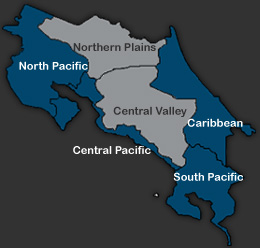
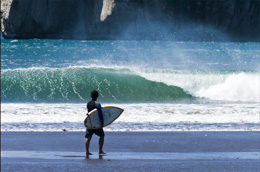
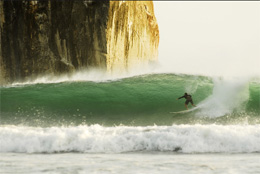
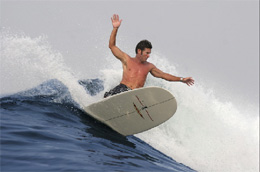
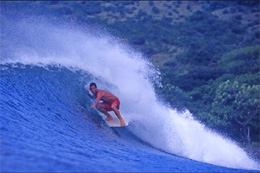
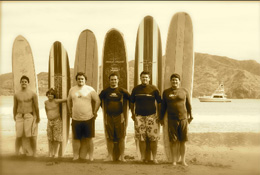
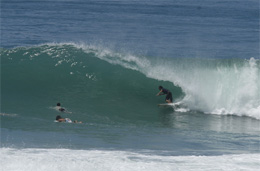
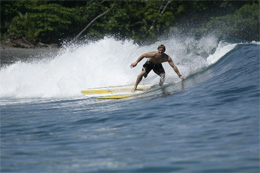
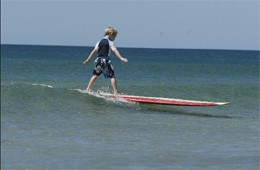
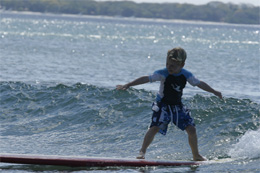
|
Guanacaste
Although, strong northerly offshore winds blow consistently during the dry season months from December to March, providing waves around the area, it's important to note that Guanacaste is unique in that the storms of the rainy season also bring up regular swell making the breaks along this particular part ideal for April through November, as well-particularly the later part of that timeframe.
Potrero Grande (Ollie`s Point) - So named because Oliver North was said to have done some evil deeds near here, this is a low tide, long right point break. Only accessable by boat .
Playa Naranjo (Witch's Rock in Santa Rosa National Park) - This world-famous geological formation acts as a point for strong offshore winds, particularly from December to March, and creates beach breaks in all directions, which work best with the incoming high tide.
Playa Grande - (Las Baulas National Marine Park)-Offers a long, pristine beach break with lefts and rights, featuring consistent offshore winds.
Tamarindo - The best place to learn to surf. With the bay enclosed on all sides, there is a slow beach break out front, and an estuary as well.
Langosta (Las Baulas National Marine Park) - The largest and strongest wave of Tamarindo, a right and left point break that curls off a river mouth.
Avellanas - Beautiful scenery and a long strip of surf choices from Little Hawaii near the river mouth, with its right-to-the-beach breaks, to the point with left-breaking waves over the reef in front of the main parking lot. Great beach Bar & Restaurant located in front of the surf break .
Playa Negra - Very fast tubes come off a right point break. Just 5 km south of Playa Avellanas.
Nosara (Ostional Wildlife National Refugee) - This beach break produces rights and lefts with some shallow-rock reef lefts that get barrelling with swell.
Playa Guiones - A little further south, this is another beach break, a left point. More consistent as a year-round surf spot - better for the veteran - and is less crowded to boot.
Mal Pais - A specific beach break as well as a catch-all name for spots including El Carmen, Los Suecos, Punta Barrigona, Santa Teresa, Playa Hermosa and Manzillo. With its southwest geographical position, surfers have the potential to surf this area all day long, and all year long. This area is absolutely gorgeous.
Central Pacific
Only two hours away from San Jose by car, the best time for these beaches are during the rainy season months of April to November, when the south swells pump up the waves. However, these waves are known to go off high all year round.
Boca Barranca - The dark water is only rainwater runoff, and that's great, because this river mouth break is a very long left and ranked favorably in Costa Rica.
Puerto Caldera - Another very good left. Just 3 km south of Boca Barranca.
Playa Tivives and Valor - This area provides a variety of waves including Tivives' beach breaks to the rocky point of Valor, with good quality rights and lefts. At the rivermouth you will also find a good left. In order to get to Valor, however, you will need to paddle across the river then walk through the trails.
Playa Escondida - Accessible only by boat from Playa Herradura, but on a good swell, this excellent point break peaks up forming a very good left and a nice right.
Playa Jaco - Another excellent learners spot that is a fun, beach break when the surf is small. However, the spot tends to close out when it gets some swell.
Roca Loca - Crazy Rock is about 1.5 km south of Jaco, and to get to this rocky point you will need to climb down a deep cliff, paddle out across a rocky strait. Why bother? That's up to you, especially since you need to be extra careful: This wave breaks right over submerged, shallow rocks. Definitely needs swell.
Playa Hermosa - The crown jewel of the area! A very strong, and long stretch of beach break that is generally best when the tide is rising, but don't limit yourself. The pros love this spot because it's the most consistent beach break on the Pacific Coast (along with Dominical) where deep water off the coast and exposure to different swells have built up a variety of sand bars. There is one is located in front of Hotel Terraza del Pacifico-the only night-surfing spot in Costa Rica-and other preferred ones are in front of Hotel Backyard, and all along that line-the Almendro, La Curva and Tulin.
Playas Esterillos Este/Oeste, Bejuco, Boca Damas - All of these beach breaks provide good waves, and are located very close to Playa Hermosa.
South Pacific
The South Pacific is for the adventurous as the travel from the international airports is longer. However, keep in mind, the prize might be worth it; that would be the desperate range of waves to choose from including the world-renowed Pavones left-one of the longest in the world-to many other surprises that avail themselves during the prime time of April through November.
Quepos - Small, small, small left point in the rivermouth. The better spot is Playita at the northern end, a beach break with lefts and rights forming good shape.
Playa El Rey - This is a beach break with rights and lefts, located a 25-minute drive south of Quepos on the unpaved roads to Playa Dominical, where you turn right at Roncador, and enter toward the sea inside a palm tree plantation.
Playa Dominical - Surf this powerful beach break, with lefts and rights, in a fantastic tropical environment.
Drake's Bay-With access only by boat, this remote, wild region of Costa Rica, offers long, powerful waves when there's a big swell. Well worth the adventure.
Pavones - If the swell is going, the left can be as long as 800-meters. Excellent, excellent ride, considered world-class, with good shape, and fast. A must-visit wave.
Punta Burrica - Explore on your own; these are very remote reef breaks accessible only by boat. This is the last beach to the South.
Caribbean Side
Flavored by exotic culture that is distinctly Caribbean, the surf experience on the East Coast is special. The waves along the right coast are for expert surfers, as they are more treacherous, breaking above coral reefs, and forming into the biggest surf in the country. These powerful tubes are generated by the prevailing Easterly trade winds and strong cold fronts that push down from the United States in the winter. Although these trade winds do blow year-round, they pump up from the prime months of January through April, and things get gnarly good. At times in the summer, when tropical storms and hurricanes move throughout the Caribbean seas, huge surf can also be found in this Costa Rican area.
Most Tico surf guides recommend that because of the nature of the Caribbean region, it is best to surf with the locals, people who are familiar with these potent breaks.
Manzanillo - Secluded, exotic, consistent and fast beach break with right and left point breaks, both with tubular sections.
Salsa Brava - The King of Costa Rican waves, so be careful and only paddle out if you are an experienced surfer. This is a thick, voluminous, Hawaiian-style wave, that comes from deep water onto a shallow reef. Salsa Brava gets very big, steep and tubular. Bring more than one board.
Black Beach, Cahuita - A good private spot, and an excellent beach break that seems to get waves year round.
Playa Bonita - Another thick, powerful and dangerous left, point and reef break north of the town of Limon.
Isla Uvita - A 20-minute boat ride from Limon, with passage only available at certain times of the year. The wave is a powerful left.
|
|
Other Tours
|
|